Seismic Response of Shield Tunnel with Double-Layer Lining
Abstract
:1. Introduction
2. Engineering Background
3. Finite Element Model of Shield Tunnel
3.1. The Numerical Model
3.2. Input Seismic Motion and Dynamic Boundary
4. Result Analysis
4.1. Structural Acceleration
4.2. Structural Stress
4.3. Structural Deformation
5. Influence of Calculation Parameters on Dynamic Response of Double-Layer Lining Shield Tunnel
5.1. Segmental Lining Stiffness Degradation
5.1.1. Structural Bending Moment
5.1.2. Structural Axial Force
5.2. Tunnel Burial Depth
5.2.1. Structural Bending Moment
5.2.2. Structural Axial Force
6. Conclusions
- The tunnel structure and surrounding stratum exhibit an increasing trend in acceleration amplification factors from the invert to the crown. Due to the intense interaction between the surrounding stratum and segmental lining, their acceleration amplification factors at the corresponding characteristic positions are nearly identical.
- The stresses in the segmental lining are greater than those in the secondary lining at all locations, with peak stresses occurring in the right springing. The stress in the segmental lining at this location is 2.61 MPa, while it is 0.87 MPa in the secondary lining, indicating an approximately threefold difference. This suggests that the segment remains the primary load-bearing structure under seismic loads.
- As the stiffness of the segmental lining decreases, its bending moment gradually decreases, while the bending moment in the secondary lining remains almost unchanged. The bending moment in the segmental lining consistently exceeds that in the secondary lining. When the segmental lining stiffness decreases from 100% to 60%, the maximum positive bending moment ratios decrease from 4.77 to 2.86, a reduction of 40.04%, indicating a significant change in load distribution under seismic loads. Additionally, the axial force in the segmental lining does not change significantly, but the axial force in the secondary lining decreases markedly.
- With increasing burial depth, the bending moment of the tunnel structure initially increases and then decreases. When the burial depths are 0.5D, 2D, and 5.0D, the ratios of the maximum positive bending moment between the segmental lining and secondary lining initially decrease and then increase, which are 7.56, 4.78, and 7.70, respectively. The segmental lining remains the primary load-bearing structure in the shield tunnel with double-layer lining.
- Increasing the segmental lining stiffness in shield tunnels is beneficial for enhancing seismic performance. Additionally, seismic internal forces in the shield tunnel reach their maximum value at a burial depth of 2D. Therefore, while ensuring structural safety, efforts should be made to maximize the burial depth of the tunnel (>2D).
Author Contributions
Funding
Institutional Review Board Statement
Informed Consent Statement
Data Availability Statement
Acknowledgments
Conflicts of Interest
References
- Pitilakis, K.; Tsinidis, G.; Leanza, A.; Maugeri, M. Seismic behaviour of circular tunnels accounting for above ground structures interaction effects. Soil. Dyn. Earthq. Eng. 2014, 67, 1–15. [Google Scholar] [CrossRef]
- Zou, Y.; Zhang, Y.; Liu, H.; Liu, H.; Miao, Y. Performance-based seismic assessment of shield tunnels by incorporating a nonlinear pseudostatic analysis approach for the soil-tunnel interaction. Tunn. Undergr. Space Technol. 2021, 114, 103981. [Google Scholar] [CrossRef]
- Shen, Y.; Zhong, Z.; Li, L.; Du, X.; Hesham El Naggar, M. Seismic response of shield tunnel structure embedded in soil deposit with liquefiable interlayer. Comput. Geotech. 2022, 152, 105015. [Google Scholar] [CrossRef]
- Zhang, S.; Yang, Y.; Yuan, Y.; Li, C.; Qiu, J. Experimental investigation of seismic performance of shield tunnel under near-field ground motion. Structures 2022, 43, 1407–1421. [Google Scholar] [CrossRef]
- Wu, H.; Ye, Z.; Zhang, Y.; Liu, H.; Liu, H. Seismic response of a shield tunnel crossing saturated sand deposits with different relative densities. Soil. Dyn. Earthq. Eng. 2023, 166, 107790. [Google Scholar] [CrossRef]
- Sun, F.; Shi, L.; Wang, J.; Wang, G. Seismic response analysis of close-distance cross tunnels: Shaking table test and numerical parameter analysis. Structures 2023, 50, 1670–1685. [Google Scholar] [CrossRef]
- Liu, C.; Peng, Z.; Cui, J.; Huang, X.; Li, Y.; Chen, W. Development of crack and damage in shield tunnel lining under seismic loading: Refined 3D finite element modeling and analyses. Thin Wall Struct. 2023, 185, 110647. [Google Scholar] [CrossRef]
- Wang, J.; Liu, H. Transverse seismic responses of a shield tunnel considering the influence of segment joints. Tunn. Undergr. Space Technol. 2023, 142, 105423. [Google Scholar] [CrossRef]
- Xu, L.; Guo, J.; Xu, C.; Chen, R.; Lin, J. Study on Dynamic Response of Soil Layer at the Bottom of Subway Shield Tunnel Under Seismic Action. Geotech. Geol. Eng. 2023, 41, 1635–1646. [Google Scholar] [CrossRef]
- Zhao, Z.; Cui, J.; Liu, C.; Liu, H.; Rehman, M.U.; Chen, W.; Peng, Z. Seismic damage characteristics of large-diameter shield tunnel lining under extreme-intensity earthquake. Soil. Dyn. Earthq. Eng. 2023, 171, 107958. [Google Scholar] [CrossRef]
- Yan, Q.; Yao, C.; Yang, W.; He, C.; Geng, P. An Improved Numerical Model of Shield Tunnel with Double Lining and Its Applications. Adv. Mater. Sci. Eng. 2015, 2015, 430879. [Google Scholar] [CrossRef]
- Yang, F.; Cao, S.; Qin, G. Mechanical behavior of two kinds of prestressed composite linings: A case study of the Yellow River Crossing Tunnel in China. Tunn. Undergr. Space Technol. 2018, 79, 96–109. [Google Scholar] [CrossRef]
- Wang, S.; Ruan, L.; Shen, X.; Dong, W. Investigation of the mechanical properties of double lining structure of shield tunnel with different joint surface. Tunn. Undergr. Space Technol. 2019, 90, 404–419. [Google Scholar] [CrossRef]
- Wang, S.; Jian, Y.; Lu, X.; Ruan, L.; Dong, W.; Feng, K. Study on load distribution characteristics of secondary lining of shield under different construction time. Tunn. Undergr. Space Technol. 2019, 89, 25–37. [Google Scholar] [CrossRef]
- Guo, R.; Zhang, M.; Xie, H.; He, C.; Fang, Y.; Wang, S. Model test study of the mechanical characteristics of the lining structure for an urban deep drainage shield tunnel. Tunn. Undergr. Space Technol. 2019, 91, 103014. [Google Scholar] [CrossRef]
- Li, Z.; Li, J.; Lin, G. A precise radiation boundary method for dynamic response of a double-layered tunnel embedded in a layered half-space. J. Appl. Geophys. 2019, 162, 93–107. [Google Scholar] [CrossRef]
- Wang, Y.; Cao, R.; Pi, J.; Jiang, L.; Zhao, Y. Mechanical properties and analytic solutions of prestressed linings with un-bonded annular anchors under internal water loading. Tunn. Undergr. Space Technol. 2020, 97, 103244. [Google Scholar] [CrossRef]
- Zhang, D.; Bu, X.; Pang, J.; Zhou, W.; Jiang, Y.; Jia, K.; Yang, G. Soil effect on the bearing capacity of a double-lining structure under internal water pressure. J. Zhejiang Univ. A Sci. 2022, 23, 863–881. [Google Scholar] [CrossRef]
- Zhang, D.; Zhou, W.; Bu, X.; Jiang, Y.; Jia, K.; Yang, G. Failure mechanism and stiffness degradation of double lining with inner R/FRC lining subjected to internal water pressure. Tunn. Undergr. Space Technol. 2022, 130, 104737. [Google Scholar] [CrossRef]
- Wang, S.; Wang, Y.; Lin, Z.; Song, Z.; Wang, X.; Peng, X. Analysis of the influence of the thickness insufficiency in secondary lining on the mechanical properties of Double-layer lining of shield tunnel. Eng. Fail. Anal. 2022, 141, 106663. [Google Scholar] [CrossRef]
- Chai, S.; Yan, Y.; Hu, B.; Wang, H.; Hu, J.; Chen, J.; Fu, X.; Zhou, Y. The Optimization of Secondary Lining Construction Time for Shield Tunnels Based on Longitudinal Mechanical Properties. Appl. Sci. 2023, 13, 10772. [Google Scholar] [CrossRef]
- Mai, S.; Tang, X.; Lu, A.; Yan, Z.; He, H. Full-scale model test for the performance of DDS prestressed composite lining with SCC-NC of high internal pressure shield tunnel. Tunn. Undergr. Space Technol. 2024, 144, 105528. [Google Scholar] [CrossRef]
- Xin, C.L.; Wang, Z.Z.; Zhou, J.M.; Gao, B. Shaking table tests on seismic behavior of polypropylene fiber reinforced concrete tunnel lining. Tunn. Undergr. Space Technol. 2019, 88, 1–15. [Google Scholar] [CrossRef]
- Zhou, T.; Dong, C.; Fu, Z.; Li, S. Study on Seismic Response and Damping Performance of Tunnels with Double Shock Absorption Layer. KSCE J. Civ. Eng. 2022, 26, 2490–2508. [Google Scholar] [CrossRef]
- Zhang, S.; Yuan, Y.; Yang, Y.; Li, C.; Yu, H. Experimental investigation of seismic performance of segmental tunnel with secondary lining under strong earthquake. Structures 2024, 60, 105833. [Google Scholar] [CrossRef]
- Koizumi, A. Segment Design of Shield Tunnel, 1st ed.; China Architecture & Building Press: Beijing, China, 2012; pp. 57–58. [Google Scholar]
- Zhang, X. Research on the Route Scheme of Shiziyang Crossing Pearl River Project of Foshan-Dongguan Intercity Railway. J. Railw. Eng. Soc. 2020, 37, 35–39. [Google Scholar]
- Yu, H.; Chen, J.; Bobet, A.; Yuan, Y. Damage observation and assessment of the Longxi tunnel during the Wenchuan earthquake. Tunn. Undergr. Space Technol. 2016, 54, 102–116. [Google Scholar] [CrossRef]
- Zucca, M.; Valente, M. On the limitations of decoupled approach for the seismic behaviour evaluation of shallow multi-propped underground structures embedded in granular soils. Eng. Struct. 2020, 211, 110497. [Google Scholar] [CrossRef]
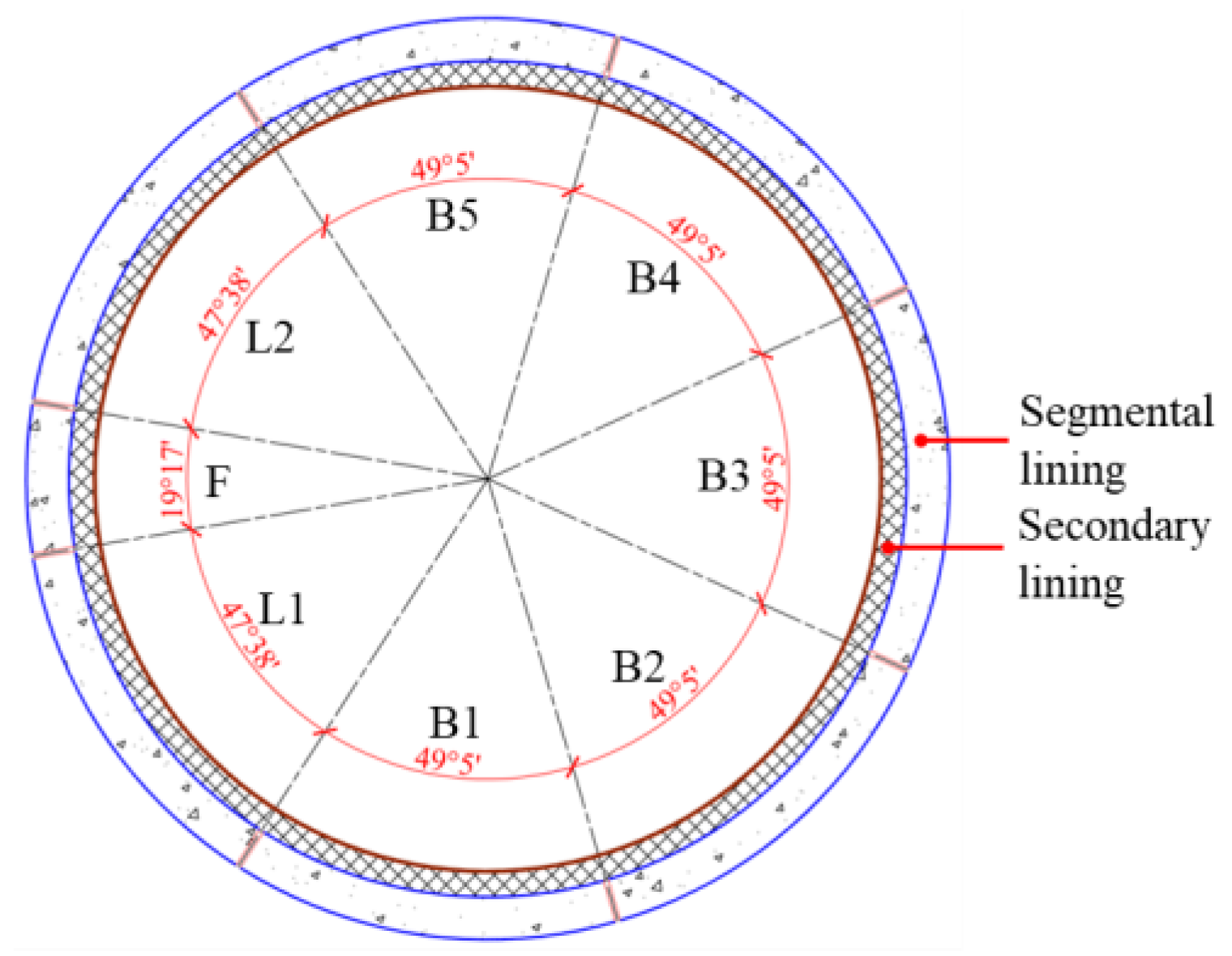
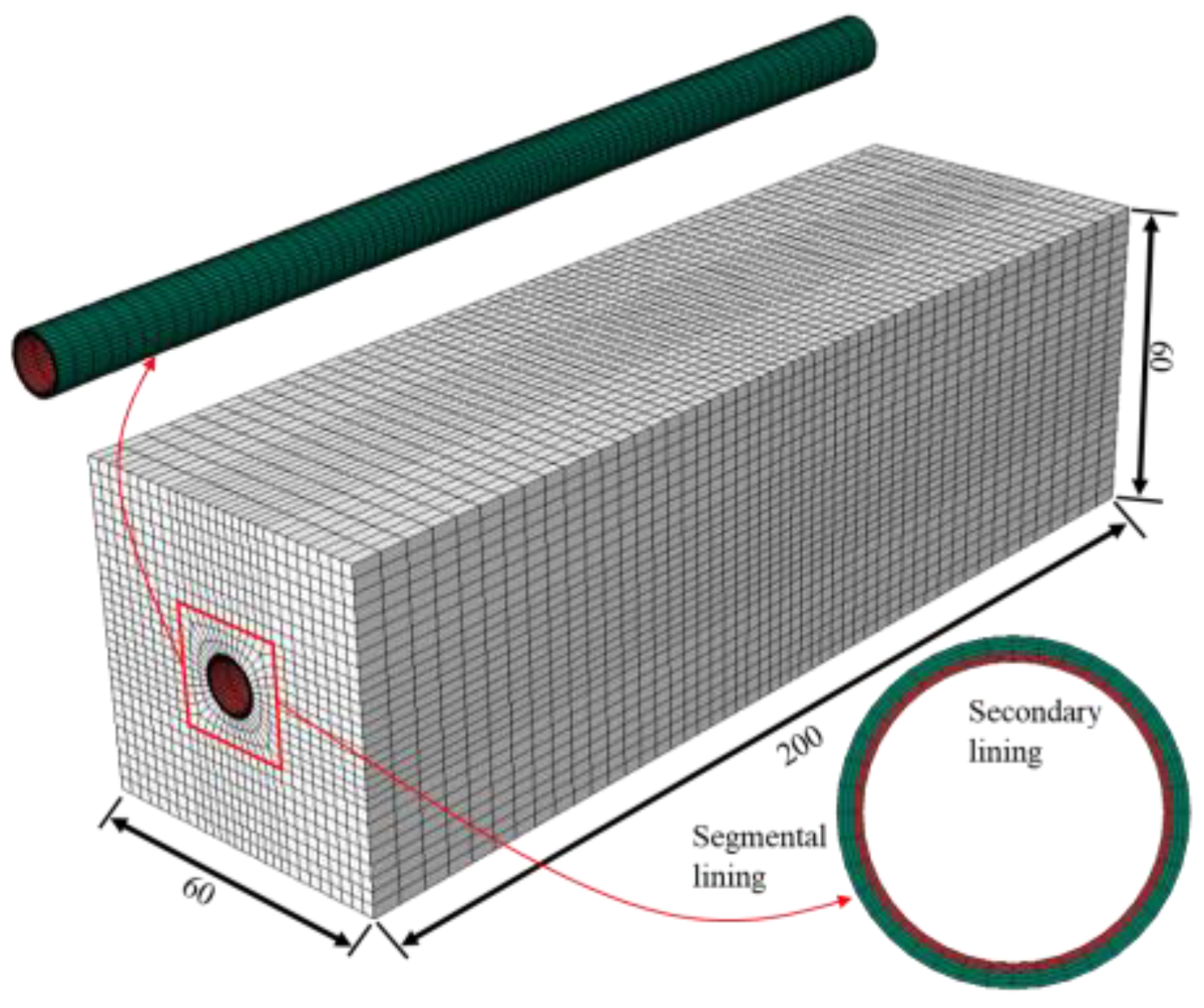

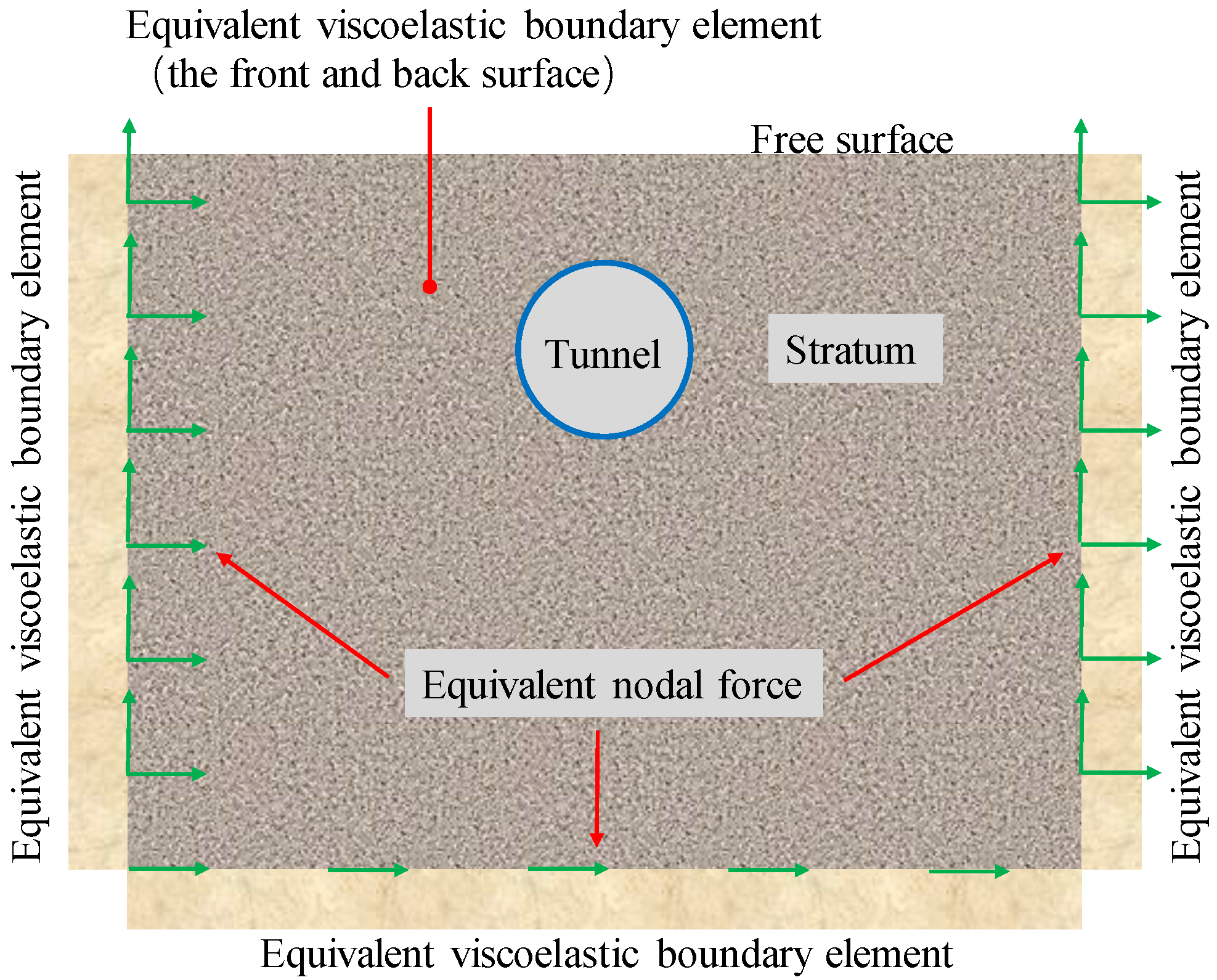
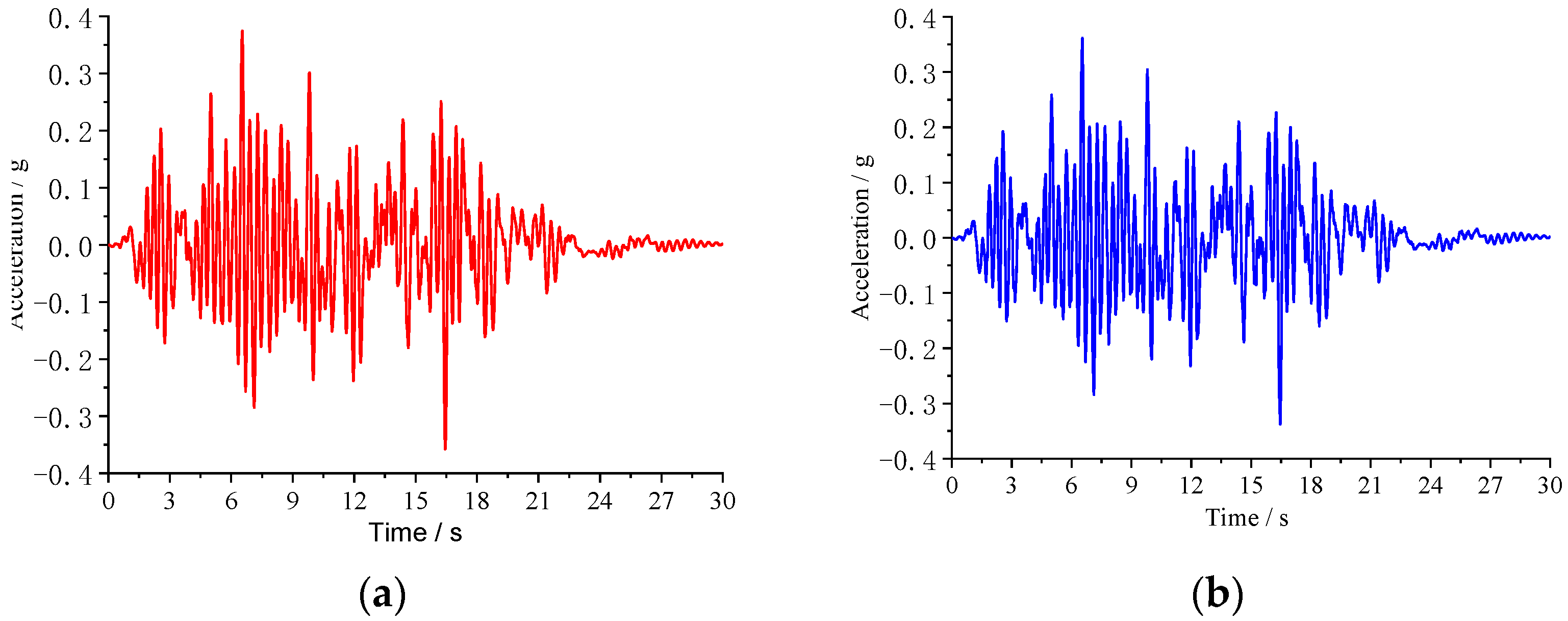

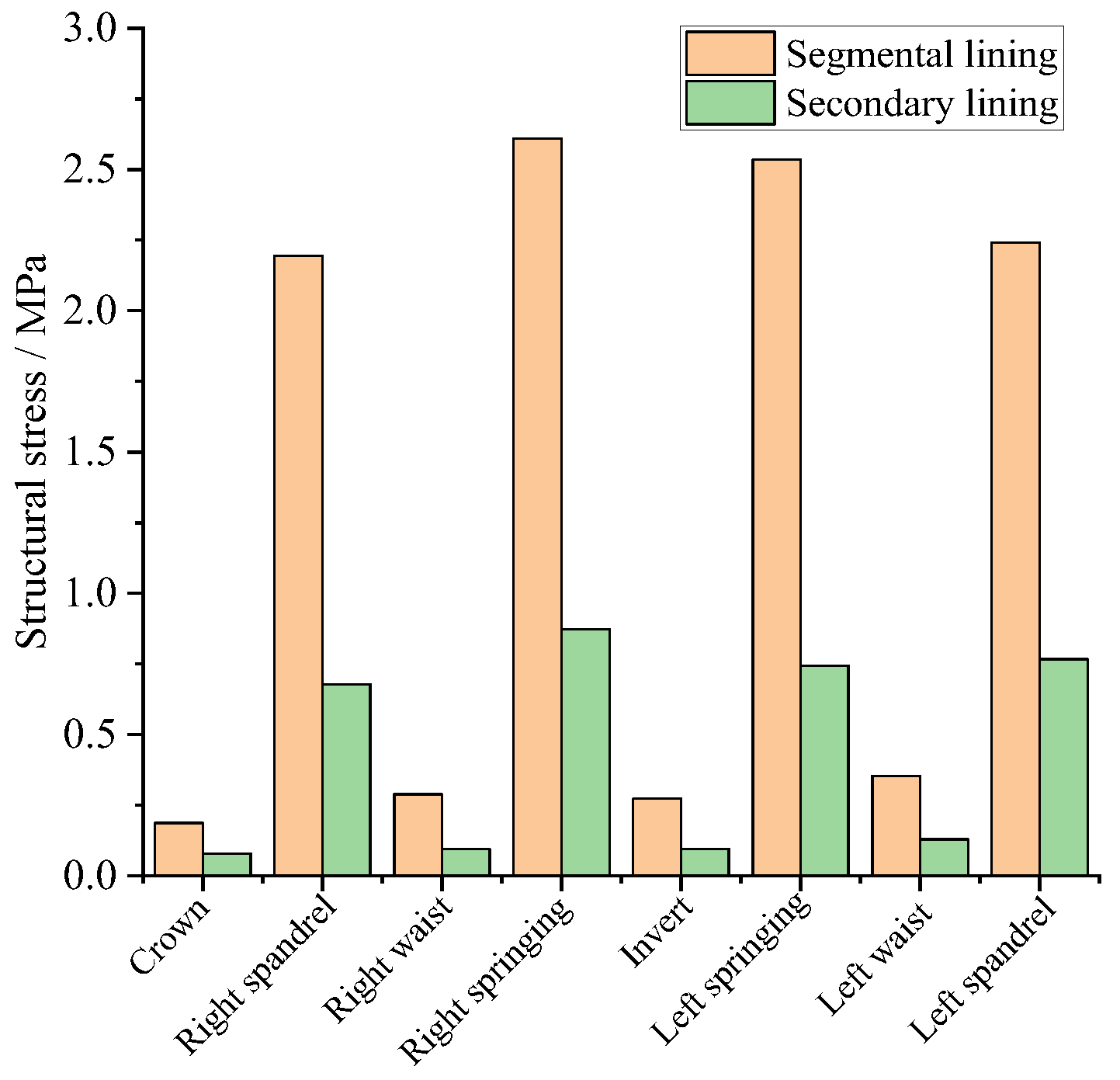

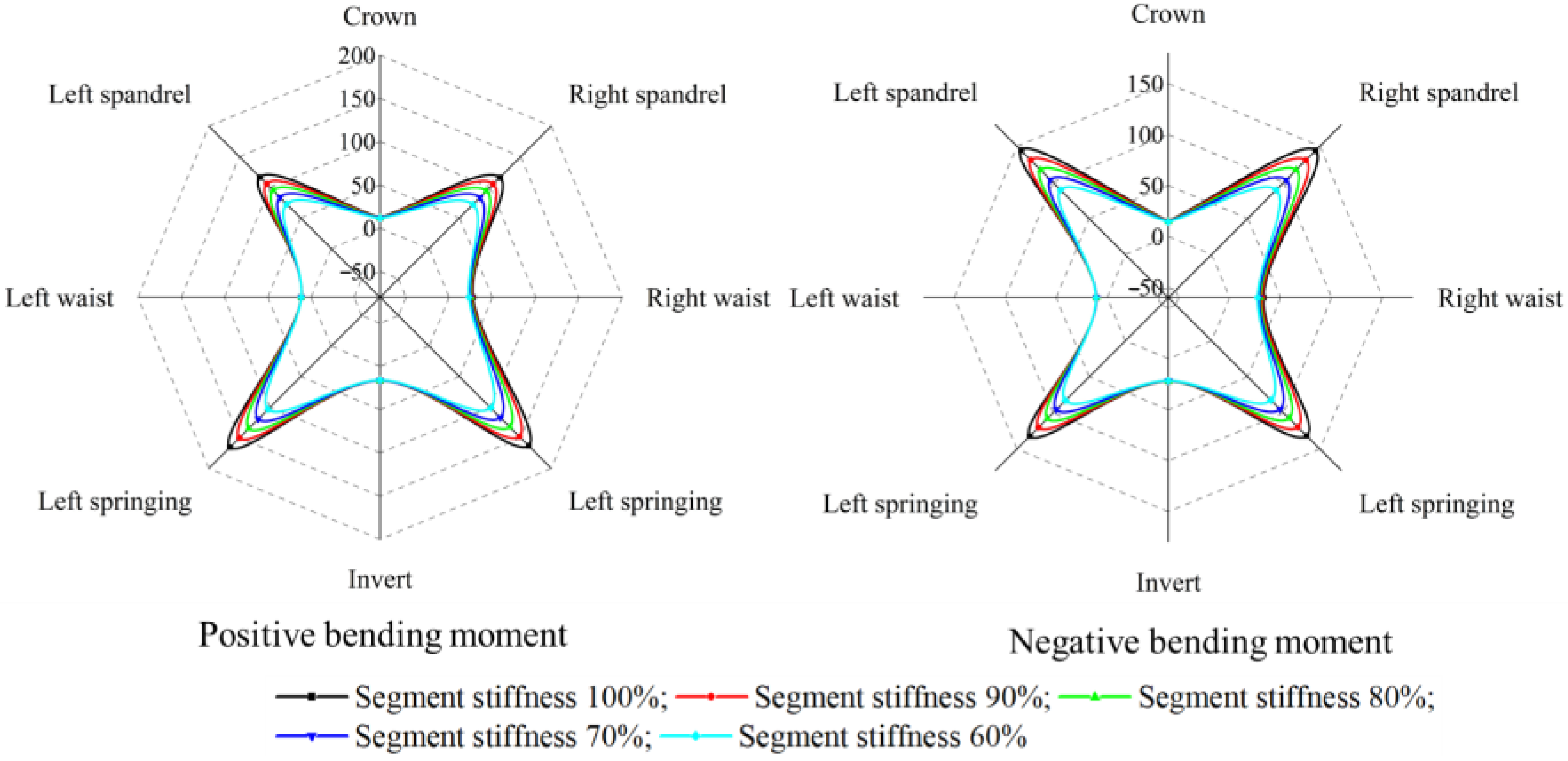
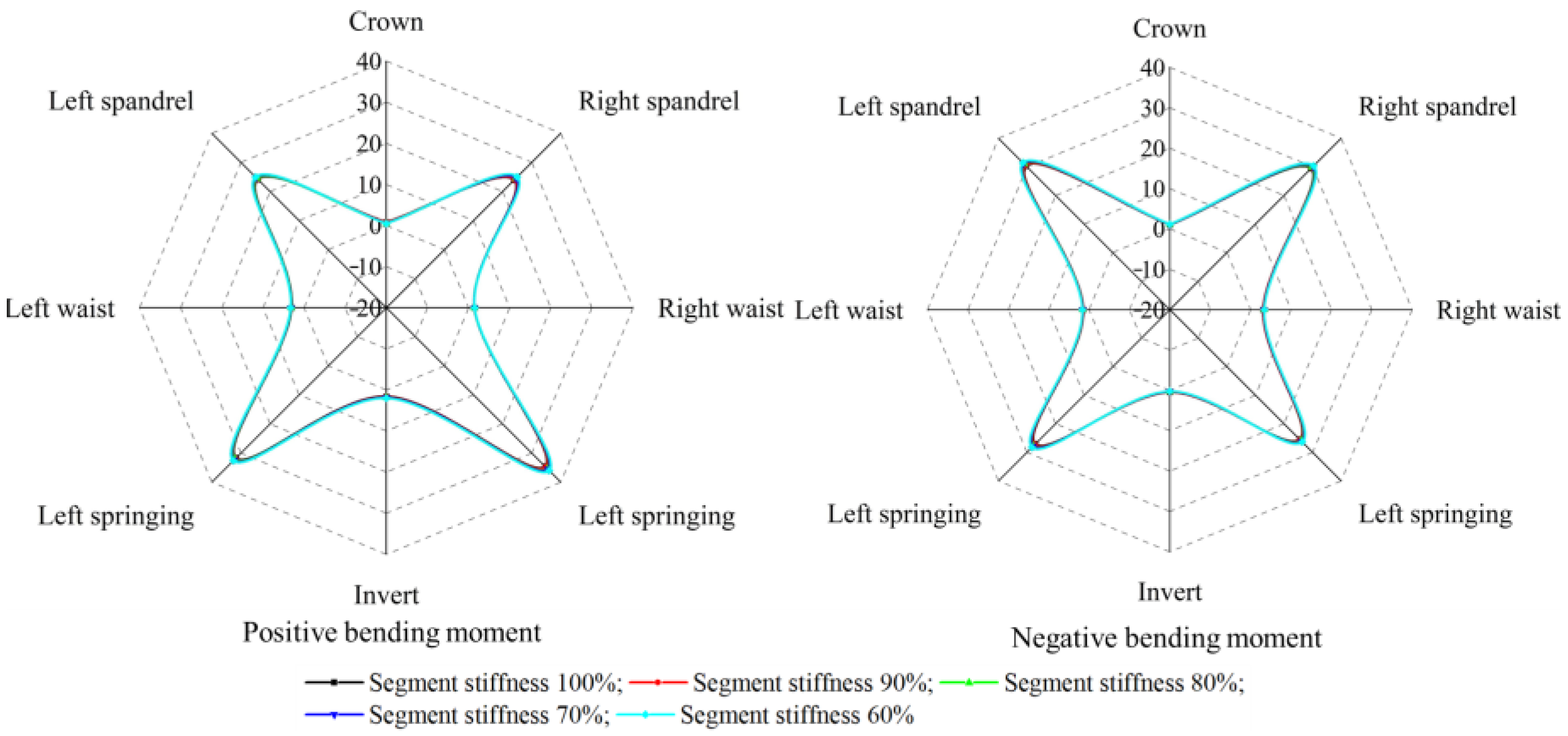
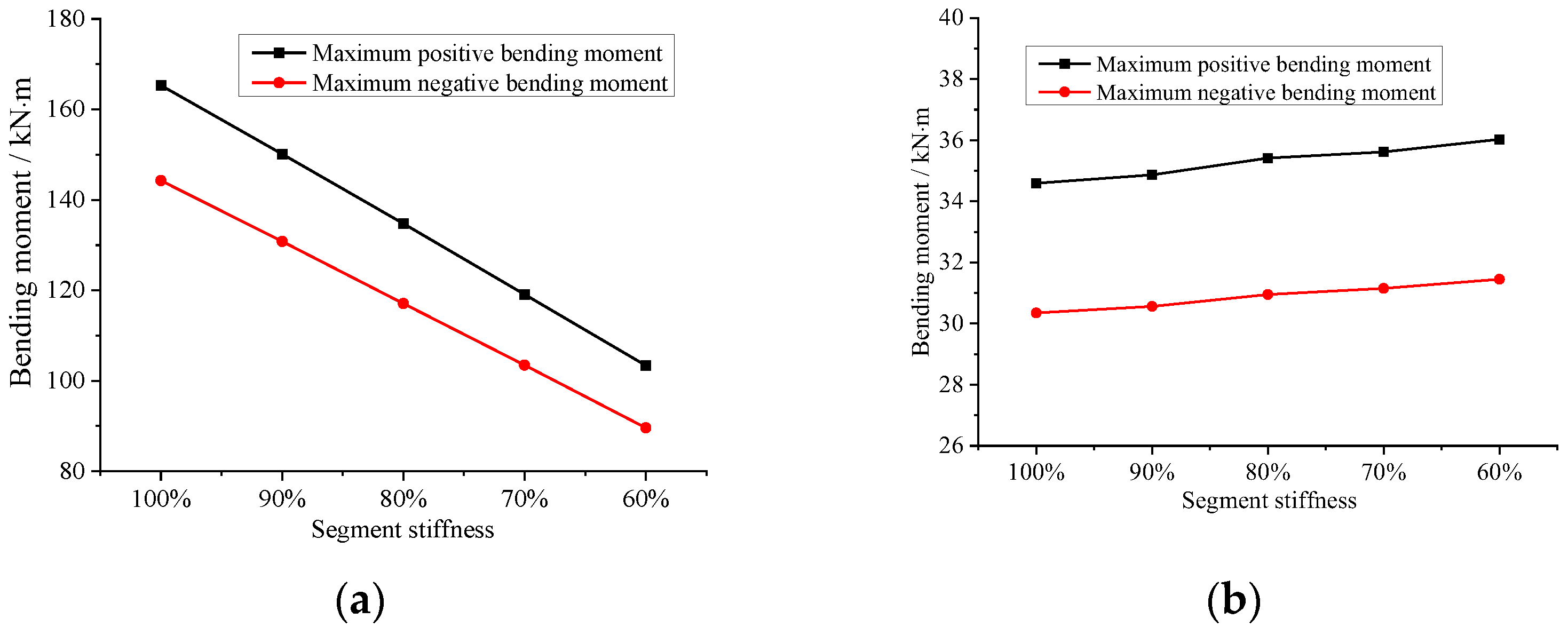
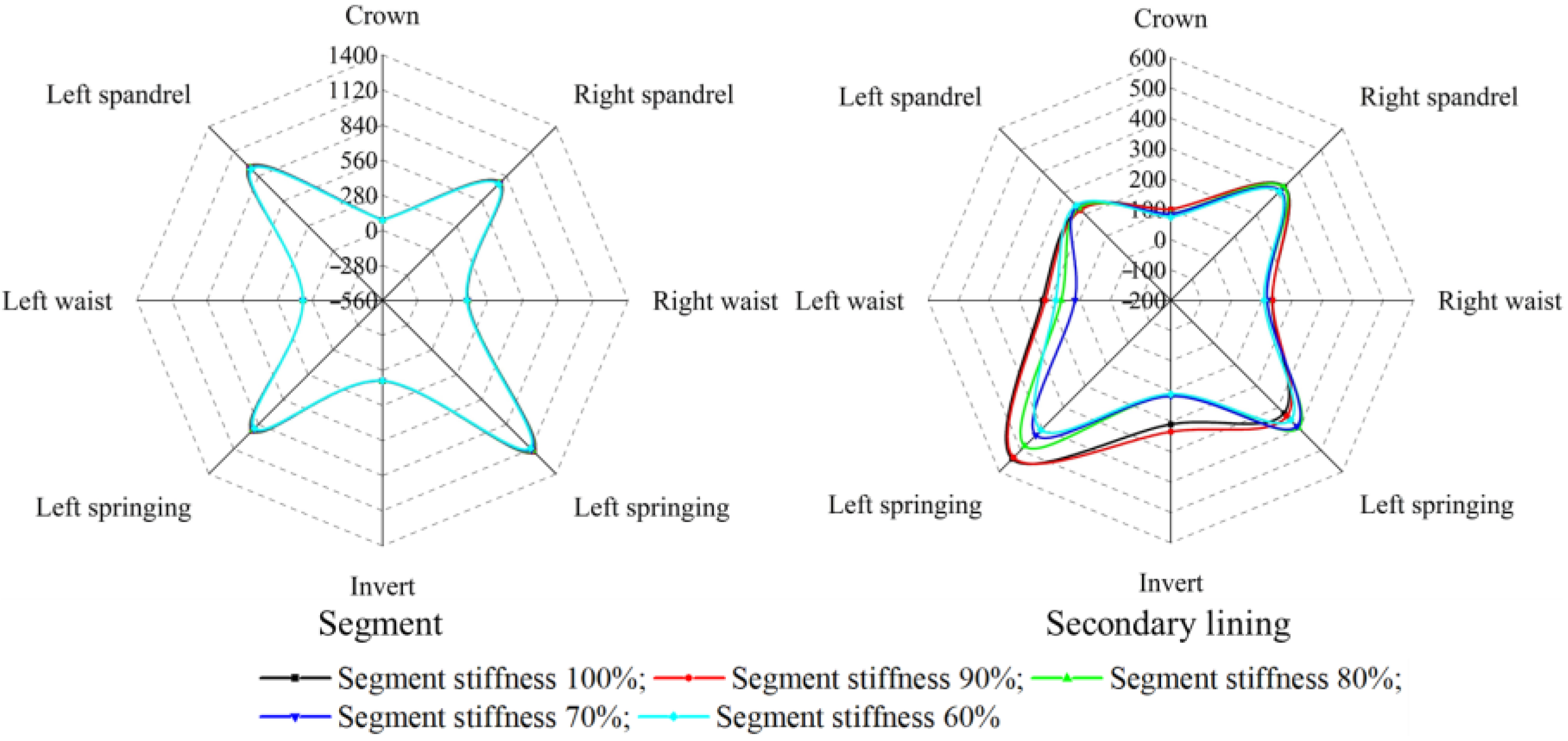

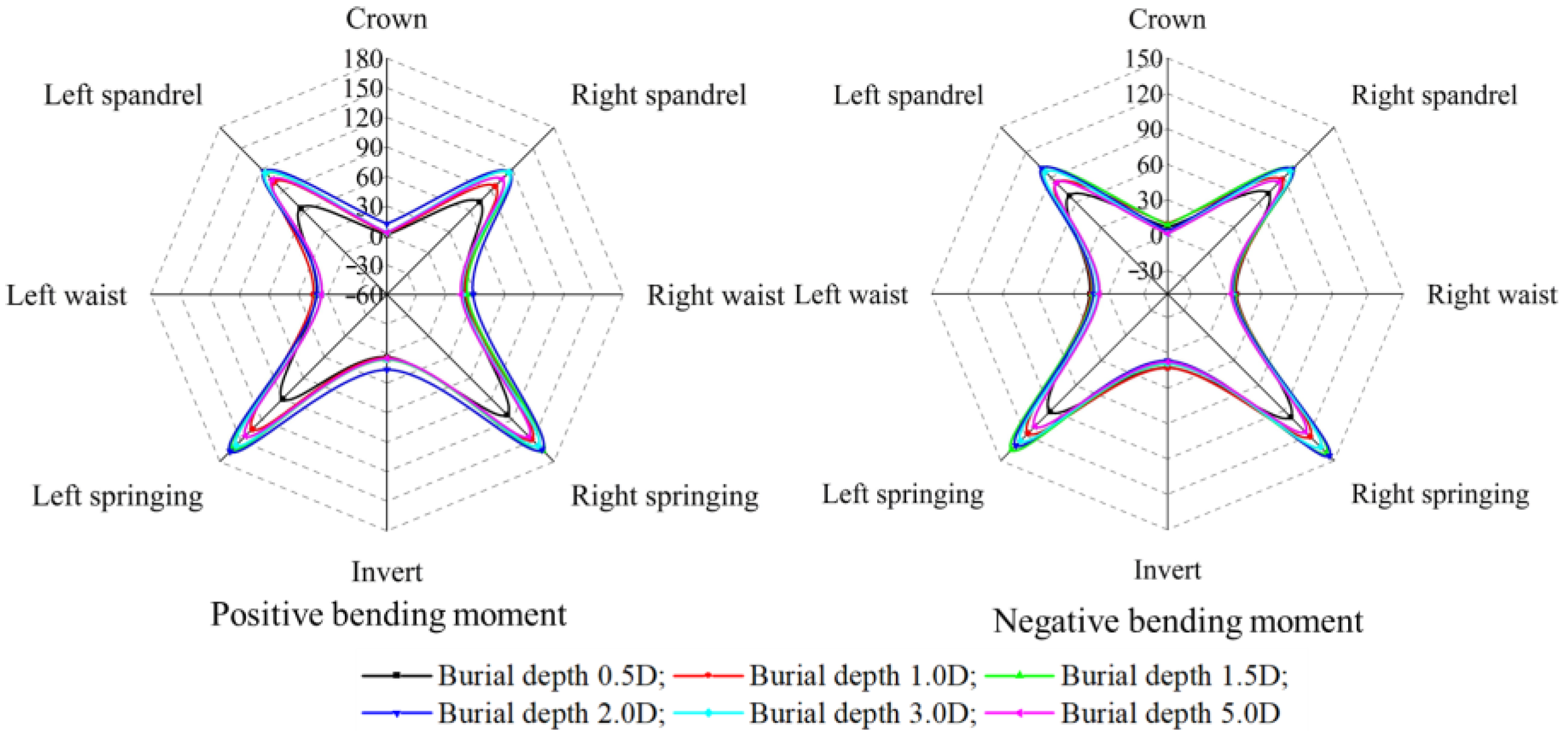


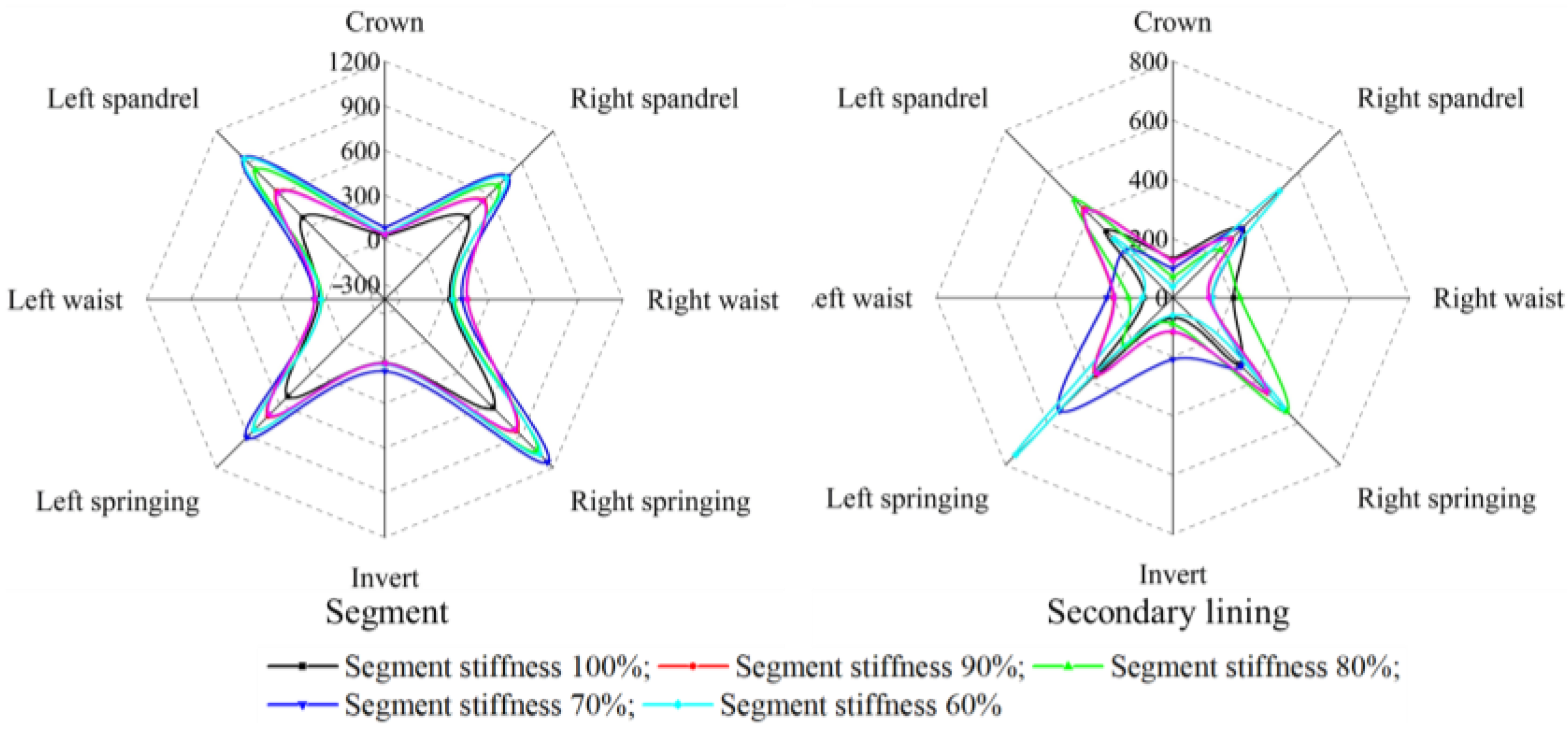
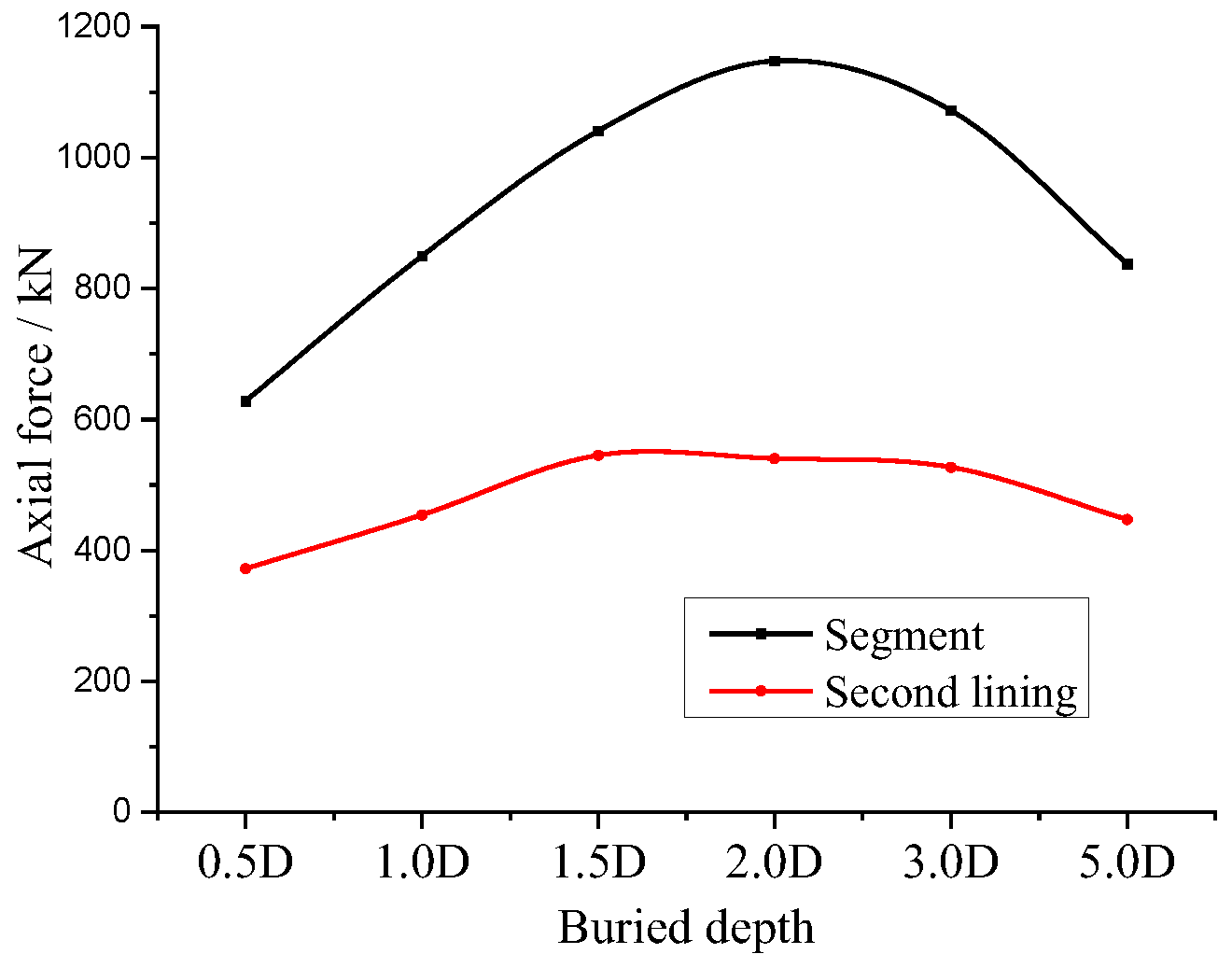

| Material | Density (kg/m3) | Young’s Modulus (Mpa) | Poisson’s Ratio | Friction Angle (°) | Cohesion (Mpa) |
|---|---|---|---|---|---|
| Stratum | 2000 | 450 | 0.3 | 30 | 0.3 |
| Segmental lining | 2500 | 34,500 | 0.2 | \ | \ |
| Secondary lining | 2500 | 28,000 | 0.2 | \ | \ |
| Bolt | 7850 | 210,000 | 0.2 | \ | \ |
Disclaimer/Publisher’s Note: The statements, opinions and data contained in all publications are solely those of the individual author(s) and contributor(s) and not of MDPI and/or the editor(s). MDPI and/or the editor(s) disclaim responsibility for any injury to people or property resulting from any ideas, methods, instructions or products referred to in the content. |
© 2024 by the authors. Licensee MDPI, Basel, Switzerland. This article is an open access article distributed under the terms and conditions of the Creative Commons Attribution (CC BY) license (https://creativecommons.org/licenses/by/4.0/).
Share and Cite
Guo, X.; Cai, Q. Seismic Response of Shield Tunnel with Double-Layer Lining. Appl. Sci. 2024, 14, 5318. https://doi.org/10.3390/app14125318
Guo X, Cai Q. Seismic Response of Shield Tunnel with Double-Layer Lining. Applied Sciences. 2024; 14(12):5318. https://doi.org/10.3390/app14125318
Chicago/Turabian StyleGuo, Xiangyu, and Qipeng Cai. 2024. "Seismic Response of Shield Tunnel with Double-Layer Lining" Applied Sciences 14, no. 12: 5318. https://doi.org/10.3390/app14125318
APA StyleGuo, X., & Cai, Q. (2024). Seismic Response of Shield Tunnel with Double-Layer Lining. Applied Sciences, 14(12), 5318. https://doi.org/10.3390/app14125318






